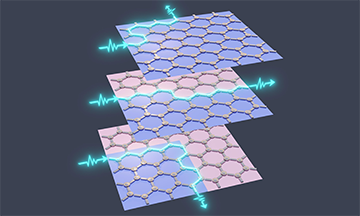
Researchers at the EPFL in Switzerland and the University of Lyon in France say that a particularly robust topological insulator they have developed could lead to new kinds of reconfigurable, unidirectional energy guiding. [Image: Zhe Zhang / EPFL 2021]
Physicists in Switzerland and France have demonstrated a new type of topological insulator that is particularly resilient to defects and other types of disorder (Nature, doi: 10.1038/s41586-021-03868-7). They say the system—which the team tested in a series of tabletop experiments at microwave frequencies—could be exploited in applications involving energy or data transmission, such as 5G communications.
Knotty wavefunction
Topological insulators are exotic materials housing electrons whose wavefunctions contain a sort of knot. That knot prevents a smooth transition between the materials’ bulk, which is insulating, and the outside world, causing them to conduct electromagnetic waves at their extremities.
First demonstrated experimentally in 2007, the 2D form of a topological insulator is an insulating plane with electric currents flowing around its edges. Those currents are very robust since they continue to flow even in the presence of material deformations. That has suggested the possibility of new chip-like devices for routing energy and information—whether classical or quantum-based—that could tolerate significant errors in fabrication.
A focus on scattering
In the latest work, Romain Fleury of the EPFL in Lausanne and colleagues analyzed a 2D network of what are known as non-reciprocal scatterers, each connected to their three nearest neighbors in a honeycomb structure. The links between these scatterers—described by the mathematics of unitary matrices—allow energy to flow in one direction only, and also introduce a phase delay from one scatterer to the next.
Fleury and co-workers carried out their analysis by varying the scatterers’ reflectivity. Low reflectivities corresponded to a new “anomalous” topological phase, while higher reflectivities yielded a well-established phase known as a Chern insulator. This latter phase is immune to backscattering from local defects, but fares less well against larger-magnitude, distributed disorder in the material.
As the researchers point out, the Chern insulator can only conduct (along its edges) within a certain type of band gap. In contrast, they worked out that the anomalous topological phase ought to support edge currents across all band gaps—thereby making its conduction potentially more robust to fluctuations in energy.
Testing the concept
Indeed, that is what the team found when testing the idea in a series of simulations and experiments. The researchers first modeled the effect of inserting an energy gap into their honeycomb network. They did this by fixing a bigger phase delay between scatterers in the lower half of the structure compared with those in the top half. They found that a signal fed into the top of the network propagated to the bottom when the scatterers reflected only a small fraction of the incoming energy—showing the resilience of the anomalous phase—but was diverted when the scatterers had Chern-like reflectivities.
The researchers confirmed this result experimentally by building a network of scatterers consisting of ferrite circulators connected by microstrip lines, with the lines in the top half of the network being straight and those in the bottom half made snake-like (to increase the phase delay). Representing the two phases by feeding the network with microwaves at two different frequencies, they confirmed that only in the case of the anomalous phase were electromagnetic waves emitted from the bottom of the network.
What’s more, the researchers found that the anomalous phase remained robust even when tested on an irregular network. They did so by fabricating a tabletop network in the shape of Switzerland, containing ports located at the sites of six cities around the perimeter of the country. The aim of the model was to use the anomalous topological phase to connect each “city” sequentially while simultaneously isolating the signal from any other city.
Feeding microwaves to the ports in clockwise order and mapping the field in the band of the anomalous phase, they found that in each case electromagnetic waves were emitted from the following port, and (largely) only that port—despite inaccuracies and shrinkages incurred during fabrication.
A “new generation of wave systems” for 5G?
Fleury and colleagues say that their table-top experiment is compatible with standard printed circuit board microwave technologies and off-the-shelf components. As such, they reckon it could lead to a “new generation of wave systems that can provide reconfigurable point-to-point unidirectional energy guiding.” In particular, they suggest it might in future be employed to shape multiple beams between transmitters and cellphones for 5G communication.
Before that, they say, they need to integrate the technology with field-programmable gate arrays in order to control the wave path from outside. They also plan on adding more functionalities such as small radiating elements, so allowing the technology to be used for communications.
